Rational number class 8th
Download as PPTX, PDF4 likes504 views
The document defines rational numbers as numbers that can be expressed as p/q, where p and q are integers and q is not equal to 0. It discusses properties of rational numbers such as closure under addition, subtraction, multiplication, and division. It also covers the identity properties of 0 and 1 for addition and multiplication, as well as inverse properties and representation of rational numbers on a number line.
1 of 19
Downloaded 75 times



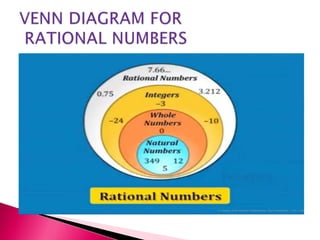

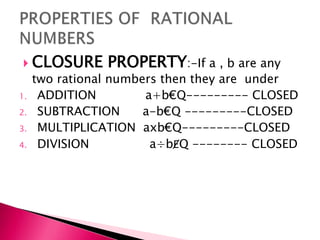


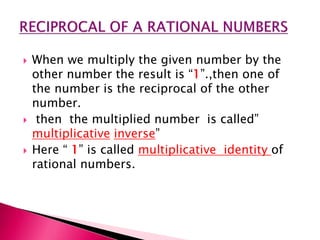










Recommended
Python final ppt



Python final pptRipal Ranpara
Ėý
The document provides an introduction and overview of the Python programming language. It discusses that Python is an interpreted, object-oriented, high-level programming language that is easy to learn and read. It also covers Python features such as portability, extensive standard libraries, and support for functional, structured, and object-oriented programming. The document then discusses Python data types including numbers, strings, and various Python syntax elements before concluding with the history and evolution of the Python language through various versions.Python and its applications



Python and its applicationsmohakmishra97
Ėý
Python is an interpreted, object-oriented programming language that is used for a wide variety of applications. It was created in the late 1980s by Guido van Rossum. As an object-oriented language, Python supports features like encapsulation, abstraction, polymorphism, and inheritance. It has grown significantly in popularity in recent years due to its simplicity, readability, and ability to power complex applications and websites. Python is used for web development, scientific computing, desktop GUIs, and more.Programming in Python 



Programming in Python Tiji Thomas
Ėý
The document provides an introduction to programming in Python. It discusses how Python can be used for web development, desktop applications, data science, machine learning, and more. It also covers executing Python programs, reading keyboard input, decision making and loops in Python, standard data types like numbers, strings, lists, tuples and dictionaries. Additionally, it describes functions, opening and reading/writing files, regular expressions, and provides examples of SQLite database connections in Python projects.Introduction to Python programming Language



Introduction to Python programming LanguageMansiSuthar3
Ėý
Python is a popular, high-level programming language that is used for a variety of tasks including web development, machine learning, and data science. It has a simple syntax and is readable. Python has built-in data types like integers, floats, booleans, strings, lists, tuples, and dictionaries. It also supports object-oriented programming. Common operations in Python include conditional statements, loops, functions, packages, file handling, classes, and data visualization using libraries like NumPy, Matplotlib, and Seaborn.Line Segment Intersections



Line Segment IntersectionsBenjamin Sach
Ėý
These are my slides from the second year Data Structures and Algorithms course I used to give at the University of Bristol.Economic interpretation of duality, shadow price and the complementary slackn...



Economic interpretation of duality, shadow price and the complementary slackn...Preety Rateria
Ėý
The document discusses the economic interpretation of duality in linear programming problems. It provides an example of a company that maximizes profit from producing two products with limited machine hours. The dual problem is to minimize the total weekly rental fees charged for each machine. The optimal solutions show the shadow prices, which interpret the profit impact of additional machine hours. A shadow price of zero indicates unused capacity, where adding hours would not increase profit.Introduction to Python



Introduction to PythonNowell Strite
Ėý
This document provides an introduction and overview of the Python programming language. It covers Python's history and key features such as being object-oriented, dynamically typed, batteries included, and focusing on readability. It also discusses Python's syntax, types, operators, control flow, functions, classes, imports, error handling, documentation tools, and popular frameworks/IDEs. The document is intended to give readers a high-level understanding of Python.Numerical Solution of Ordinary Differential Equations



Numerical Solution of Ordinary Differential EquationsMeenakshisundaram N
Ėý
1. The document discusses numerical methods for solving ordinary differential equations, including power series approximations, Taylor series, Euler's method, and the Runge-Kutta method.
2. It provides examples of using each of these methods to solve sample differential equations and compares the numerical solutions to exact solutions.
3. Truncation errors are defined as errors that result from using an approximation instead of an exact mathematical procedure.Functions in python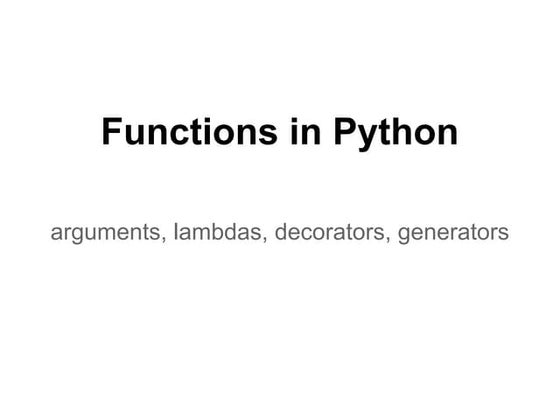



Functions in pythonIlian Iliev
Ėý
This document discusses various Python functions concepts including defining simple functions, functions with arguments, default arguments, lambda functions, generators, and decorators. It provides examples of defining functions that take positional and keyword arguments, using lambda functions, creating generators using yield, and applying decorators to functions. Various introspection methods like type(), dir(), and callable() are also covered.Separation of variables solution to solved problems



Separation of variables solution to solved problemsJuan Apolinario Reyes
Ėý
Separation of Variables, solution to problems in the book. This slide presentation accompanies my lecture in differential equations.Big m method



Big m methodLuckshay Batra
Ėý
The Big M Method is a variant of the simplex method for solving linear programming problems. It introduces artificial variables and a large number M to convert inequalities into equalities. The transformed problem is then solved using the simplex method, eliminating artificial variables until an optimal solution is found. However, the method has drawbacks in determining a sufficiently large M value and not knowing feasibility until optimality is reached. It is inferior to the two-phase method and not used in commercial solvers.Python dictionary



Python dictionarySagar Kumar
Ėý
This document discusses Python dictionaries. It defines a dictionary as a mutable container type that can store any number of Python objects. Dictionaries consist of pairs of keys and their corresponding values. The document provides examples of creating dictionaries, accessing values using keys, updating or adding new entries, and deleting entries or the entire dictionary. It explains the basic syntax and important features of Python dictionaries.Programming



Programmingmonishagoyal4
Ėý
This document discusses key concepts in Python programming including data types, operators, strings, modules, object-oriented programming, and connecting to SQLite databases. It provides examples of numeric, boolean, and sequence data types. It also demonstrates various math operators, string operators like concatenation and multiplication, and how to import and use modules. Object-oriented concepts like classes, attributes, and behaviors are explained using a parrot example. Finally, it mentions how to connect a SQLite database to Python code using the MySQLdb interface.Economic interpretations of Linear Programming Problem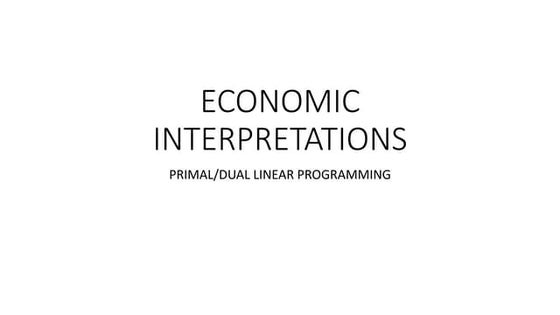



Economic interpretations of Linear Programming ProblemRAVI PRASAD K.J.
Ėý
The document discusses the economic interpretations of primal and dual linear programming. It explains that the primal problem seeks to maximize revenue under limited resources by allocating activities across resources. The dual variables represent the worth per unit of each resource. The dual constraints represent the "imputed cost" per unit of each resource, and the reduced cost of an activity is the imputed cost of resources needed to produce it. The optimality condition of the simplex method states that an unused activity should only increase if its reduced cost is negative, meaning its revenue exceeds its imputed costs, making it economically advantageous. An example of assembling toys illustrates how reduced cost can determine whether a toy is economically attractive to produce.presentation on Euler and Modified Euler method ,and Fitting of curve 



presentation on Euler and Modified Euler method ,and Fitting of curve Mukuldev Khunte
Ėý
presentation on Euler and Modified Euler method with working and example ,and Fitting of Nonlinear curve using Method of least squareLinear dependence(ld) &linear independence(li)



Linear dependence(ld) &linear independence(li)Digvijaysinh Gohil
Ėý
This document discusses linear dependence and independence of vectors. It defines linear dependence as a set of vectors that can be written as a linear combination of scalars times the vectors equaling the zero vector. Linear independence is defined as scalars equaling zero if the linear combination equals the zero vector. Examples are provided to demonstrate determining if a set of vectors is linearly dependent or independent by setting up a system of equations and calculating the determinant.Laurent Series ........ By Muhammad Umer



Laurent Series ........ By Muhammad Umersialkot123
Ėý
The document discusses the Laurent series, which represents a complex function as a power series including terms with negative powers, unlike the Taylor series. It explains that the Laurent series can be used when the Taylor series cannot be applied. The document provides an example of calculating the Laurent series for the function f(z)=1, expanding it in the regions inside and outside the circle of radius 1 centered at z=0.Basic Python Programming: Part 01 and Part 02



Basic Python Programming: Part 01 and Part 02Fariz Darari
Ėý
This document discusses basic Python programming concepts including strings, functions, conditionals, loops, imports and recursion. It begins with examples of printing strings, taking user input, and calculating areas of shapes. It then covers variables and data types, operators, conditional statements, loops, functions, imports, strings, and recursion. Examples are provided throughout to demonstrate each concept.Python training



Python trainingKunalchauhan76
Ėý
Kunal Chauhan will be conducting a 6 week Python training program from May 15th to June 26th. The training will cover introductory Python programming, basics of programming in Python including variables, data types, operators, and control flow, principles of object-oriented programming, SQLite database usage, GUI development with PyQt, and applications of Python in various disciplines like web development, machine learning, data science, and more.Rational number ppt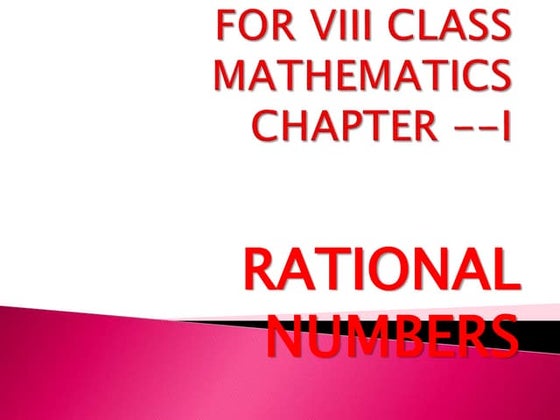



Rational number pptShivani Sharma
Ėý
Here are the steps to find 5/7 + 3/7 using appropriate properties:
1) Find a common denominator for 5/7 and 3/7:
The common denominator is 7
2) Convert 5/7 and 3/7 to equivalent fractions with the common denominator of 7:
5/7 = 5/7
3/7 = 3/7
3) Add the numerators:
5/7 + 3/7 = 8/7
4) Simplify if possible:
8/7 cannot be simplified.
Therefore, 5/7 + 3/7 = 8/7Mathematics power point presenttation on the topic



Mathematics power point presenttation on the topicMeghansh Gautam
Ėý
This document provides an overview of mathematics and different types of numbers. It discusses what mathematics is, polynomials, algebraic identities, and various number systems including natural numbers, integers, rational numbers, real numbers, complex numbers, and computable numbers. It also briefly discusses the history of numbers, mentioning that tally marks found on bones and artifacts may be some of the earliest forms of counting and record keeping.Fundamentals of AlgebraChu v. NguyenIntegral Exponents



Fundamentals of AlgebraChu v. NguyenIntegral ExponentsDustiBuckner14
Ėý
Fundamentals of Algebra
Chu v. Nguyen
Integral Exponents
Exponents
If n is a positive integer (a whole number, i.e., a number without decimal part) and x is a number, then
The number x is called the base and n is called the exponent.
The most common ways of referring to are â x to the nth power,â
â x to the nth,â or âthe nth power of x.â
Integral Exponents (cont.)
For any non-zero number x and a positive integer n
and
Note: is not defined
and
Rules Concerning Integral Exponents
Following are five rules in which m and n are positive integers:
Rule 1: ; for example,
Rule 2: ; for example
or
Rules Concerning Integral Exponents (Cont.)
Rule 3: ; for example
or
Rule 4: ; for example
or
Rule 5: ; for example
or
Basic Rules for Operating with Fractions
Since dividing by zero is not defined, we assume that the denominator
is not zero.
Following are the eight basic rules for operating with fractions.
Rule 1: ; for example
Rule 2: ; for example
Rule 3: ; for example
Basic Rules for Operating with Fractions (cont.)
Rule 4: ; for example
Rule 5: ; for example
Rule 6: ; for example
Basic Rules for Operating with Fractions (cont.)
Rule 7: ; for example
Rule 8: ; for example
Notes: a*b +a*x may be expressed as a(b + x)
a*b + 1 may be written as a(b + ), and
m*x â y may be expressed as m(x - )
Square Root
Generally, for a>0 , there is exactly one positive number x such that
, we say that x is the root of a, written as
for
When n = 2, we say that x is the square root of âaâ and is denoted by
or or
For example:
or
Practices
Carrying out the following operations:
24 ; 2-2 ; 2322, ; 252-5 ; and (2x3)5
; ; ; and
3.
4.
5.
n
m
n
m
x
x
x
+
=
n
x
1
0
)
2
(
2
2
2
=
=
=
-
+
-
x
x
x
x
1
0
=
x
0
0
n
n
n
x
x
x
x
=
=
+
0
0
n
n
x
x
1
=
-
3
2 ...2. Real numbers



2. Real numbersKanchan Gupta
Ėý
1. The document defines different types of real numbers including natural numbers, whole numbers, integers, rational numbers, and irrational numbers. It discusses their properties and how to represent them on a number line.
2. Rational numbers can be terminating or non-terminating recurring decimals. Irrational numbers have non-terminating, non-recurring decimals. Surds are irrational roots of rational numbers.
3. The document covers operations and rationalization of like surds, binomial quadratic surds, and the definition and properties of absolute value.Project in math BY:Samuel Vasquez Balia



Project in math BY:Samuel Vasquez Baliasamuel balia
Ėý
Real numbers include rational numbers like fractions as well as irrational numbers like the square root of 2. Real numbers are represented by the symbol R and include natural numbers, whole numbers, integers, rational numbers, and irrational numbers. Rational numbers can be written as fractions with integers as the numerator and non-zero denominator, while irrational numbers cannot be expressed as fractions.Project in math



Project in mathsamuel balia
Ėý
Real numbers include rational numbers like fractions and irrational numbers like square roots. Real numbers are represented by the symbol R. They consist of natural numbers, whole numbers, integers, rational numbers and irrational numbers. [/SUMMARY]9+&+10+English+_+Class+09+CBSE+2020+_Formula+Cheat+Sheet+_+Number+System+&+Po...



9+&+10+English+_+Class+09+CBSE+2020+_Formula+Cheat+Sheet+_+Number+System+&+Po...ghghghg3
Ėý
The document defines and describes various types of number systems. It discusses natural numbers, whole numbers, integers, rational numbers, irrational numbers, and real numbers. It also describes their properties and relationships. Different types of polynomials are defined based on their degree, number of terms, zeros, and factors. Methods for factorizing polynomials including taking common factors, grouping, and splitting the middle term are explained. Algebraic identities are also introduced.Integers



IntegersPunita Verma
Ėý
Integers are the set of whole numbers and their opposites, including positive and negative numbers from infinity to infinity. Each integer has an equal and opposite integer at the same distance from zero on the number line. Integers are closed under addition and multiplication, but not division, and the product of integers can be either positive or negative depending on the signs of the integers. The integers can be constructed by defining equivalence classes of pairs of natural numbers, where (a,b) represents subtracting b from a. Basic arithmetic operations of integers like addition, subtraction, multiplication and division follow predictable rules based on the signs of the integers.C1 g9-s1-t7-1



C1 g9-s1-t7-1Al Muktadir Hussain
Ėý
This document provides a summary of key concepts from Grade 9 Math Term I, including:
- Different types of numbers (natural, whole, integers, rational, irrational, real) and their properties
- Polynomials, including definitions of terms, degrees, zeros, and factoring polynomials
- The Cartesian coordinate system for identifying points on a plane using perpendicular x and y axes, with the origin at their intersection1 1 number theory



1 1 number theorysmillertx281
Ėý
The document provides an overview of topics in number theory including:
- Number systems such as natural numbers, integers, and real numbers
- Properties of real numbers like closure, commutativity, associativity, identity, and inverse properties
- Rational and irrational numbers
- Order of operations
- Absolute value
- Intervals on the number line
- Finite and repeating decimals
- Converting between fractions and decimalsMore Related Content
What's hot (11)
Functions in python



Functions in pythonIlian Iliev
Ėý
This document discusses various Python functions concepts including defining simple functions, functions with arguments, default arguments, lambda functions, generators, and decorators. It provides examples of defining functions that take positional and keyword arguments, using lambda functions, creating generators using yield, and applying decorators to functions. Various introspection methods like type(), dir(), and callable() are also covered.Separation of variables solution to solved problems



Separation of variables solution to solved problemsJuan Apolinario Reyes
Ėý
Separation of Variables, solution to problems in the book. This slide presentation accompanies my lecture in differential equations.Big m method



Big m methodLuckshay Batra
Ėý
The Big M Method is a variant of the simplex method for solving linear programming problems. It introduces artificial variables and a large number M to convert inequalities into equalities. The transformed problem is then solved using the simplex method, eliminating artificial variables until an optimal solution is found. However, the method has drawbacks in determining a sufficiently large M value and not knowing feasibility until optimality is reached. It is inferior to the two-phase method and not used in commercial solvers.Python dictionary



Python dictionarySagar Kumar
Ėý
This document discusses Python dictionaries. It defines a dictionary as a mutable container type that can store any number of Python objects. Dictionaries consist of pairs of keys and their corresponding values. The document provides examples of creating dictionaries, accessing values using keys, updating or adding new entries, and deleting entries or the entire dictionary. It explains the basic syntax and important features of Python dictionaries.Programming



Programmingmonishagoyal4
Ėý
This document discusses key concepts in Python programming including data types, operators, strings, modules, object-oriented programming, and connecting to SQLite databases. It provides examples of numeric, boolean, and sequence data types. It also demonstrates various math operators, string operators like concatenation and multiplication, and how to import and use modules. Object-oriented concepts like classes, attributes, and behaviors are explained using a parrot example. Finally, it mentions how to connect a SQLite database to Python code using the MySQLdb interface.Economic interpretations of Linear Programming Problem



Economic interpretations of Linear Programming ProblemRAVI PRASAD K.J.
Ėý
The document discusses the economic interpretations of primal and dual linear programming. It explains that the primal problem seeks to maximize revenue under limited resources by allocating activities across resources. The dual variables represent the worth per unit of each resource. The dual constraints represent the "imputed cost" per unit of each resource, and the reduced cost of an activity is the imputed cost of resources needed to produce it. The optimality condition of the simplex method states that an unused activity should only increase if its reduced cost is negative, meaning its revenue exceeds its imputed costs, making it economically advantageous. An example of assembling toys illustrates how reduced cost can determine whether a toy is economically attractive to produce.presentation on Euler and Modified Euler method ,and Fitting of curve 



presentation on Euler and Modified Euler method ,and Fitting of curve Mukuldev Khunte
Ėý
presentation on Euler and Modified Euler method with working and example ,and Fitting of Nonlinear curve using Method of least squareLinear dependence(ld) &linear independence(li)



Linear dependence(ld) &linear independence(li)Digvijaysinh Gohil
Ėý
This document discusses linear dependence and independence of vectors. It defines linear dependence as a set of vectors that can be written as a linear combination of scalars times the vectors equaling the zero vector. Linear independence is defined as scalars equaling zero if the linear combination equals the zero vector. Examples are provided to demonstrate determining if a set of vectors is linearly dependent or independent by setting up a system of equations and calculating the determinant.Laurent Series ........ By Muhammad Umer



Laurent Series ........ By Muhammad Umersialkot123
Ėý
The document discusses the Laurent series, which represents a complex function as a power series including terms with negative powers, unlike the Taylor series. It explains that the Laurent series can be used when the Taylor series cannot be applied. The document provides an example of calculating the Laurent series for the function f(z)=1, expanding it in the regions inside and outside the circle of radius 1 centered at z=0.Basic Python Programming: Part 01 and Part 02



Basic Python Programming: Part 01 and Part 02Fariz Darari
Ėý
This document discusses basic Python programming concepts including strings, functions, conditionals, loops, imports and recursion. It begins with examples of printing strings, taking user input, and calculating areas of shapes. It then covers variables and data types, operators, conditional statements, loops, functions, imports, strings, and recursion. Examples are provided throughout to demonstrate each concept.Python training



Python trainingKunalchauhan76
Ėý
Kunal Chauhan will be conducting a 6 week Python training program from May 15th to June 26th. The training will cover introductory Python programming, basics of programming in Python including variables, data types, operators, and control flow, principles of object-oriented programming, SQLite database usage, GUI development with PyQt, and applications of Python in various disciplines like web development, machine learning, data science, and more.Similar to Rational number class 8th (20)
Rational number ppt



Rational number pptShivani Sharma
Ėý
Here are the steps to find 5/7 + 3/7 using appropriate properties:
1) Find a common denominator for 5/7 and 3/7:
The common denominator is 7
2) Convert 5/7 and 3/7 to equivalent fractions with the common denominator of 7:
5/7 = 5/7
3/7 = 3/7
3) Add the numerators:
5/7 + 3/7 = 8/7
4) Simplify if possible:
8/7 cannot be simplified.
Therefore, 5/7 + 3/7 = 8/7Mathematics power point presenttation on the topic



Mathematics power point presenttation on the topicMeghansh Gautam
Ėý
This document provides an overview of mathematics and different types of numbers. It discusses what mathematics is, polynomials, algebraic identities, and various number systems including natural numbers, integers, rational numbers, real numbers, complex numbers, and computable numbers. It also briefly discusses the history of numbers, mentioning that tally marks found on bones and artifacts may be some of the earliest forms of counting and record keeping.Fundamentals of AlgebraChu v. NguyenIntegral Exponents



Fundamentals of AlgebraChu v. NguyenIntegral ExponentsDustiBuckner14
Ėý
Fundamentals of Algebra
Chu v. Nguyen
Integral Exponents
Exponents
If n is a positive integer (a whole number, i.e., a number without decimal part) and x is a number, then
The number x is called the base and n is called the exponent.
The most common ways of referring to are â x to the nth power,â
â x to the nth,â or âthe nth power of x.â
Integral Exponents (cont.)
For any non-zero number x and a positive integer n
and
Note: is not defined
and
Rules Concerning Integral Exponents
Following are five rules in which m and n are positive integers:
Rule 1: ; for example,
Rule 2: ; for example
or
Rules Concerning Integral Exponents (Cont.)
Rule 3: ; for example
or
Rule 4: ; for example
or
Rule 5: ; for example
or
Basic Rules for Operating with Fractions
Since dividing by zero is not defined, we assume that the denominator
is not zero.
Following are the eight basic rules for operating with fractions.
Rule 1: ; for example
Rule 2: ; for example
Rule 3: ; for example
Basic Rules for Operating with Fractions (cont.)
Rule 4: ; for example
Rule 5: ; for example
Rule 6: ; for example
Basic Rules for Operating with Fractions (cont.)
Rule 7: ; for example
Rule 8: ; for example
Notes: a*b +a*x may be expressed as a(b + x)
a*b + 1 may be written as a(b + ), and
m*x â y may be expressed as m(x - )
Square Root
Generally, for a>0 , there is exactly one positive number x such that
, we say that x is the root of a, written as
for
When n = 2, we say that x is the square root of âaâ and is denoted by
or or
For example:
or
Practices
Carrying out the following operations:
24 ; 2-2 ; 2322, ; 252-5 ; and (2x3)5
; ; ; and
3.
4.
5.
n
m
n
m
x
x
x
+
=
n
x
1
0
)
2
(
2
2
2
=
=
=
-
+
-
x
x
x
x
1
0
=
x
0
0
n
n
n
x
x
x
x
=
=
+
0
0
n
n
x
x
1
=
-
3
2 ...2. Real numbers



2. Real numbersKanchan Gupta
Ėý
1. The document defines different types of real numbers including natural numbers, whole numbers, integers, rational numbers, and irrational numbers. It discusses their properties and how to represent them on a number line.
2. Rational numbers can be terminating or non-terminating recurring decimals. Irrational numbers have non-terminating, non-recurring decimals. Surds are irrational roots of rational numbers.
3. The document covers operations and rationalization of like surds, binomial quadratic surds, and the definition and properties of absolute value.Project in math BY:Samuel Vasquez Balia



Project in math BY:Samuel Vasquez Baliasamuel balia
Ėý
Real numbers include rational numbers like fractions as well as irrational numbers like the square root of 2. Real numbers are represented by the symbol R and include natural numbers, whole numbers, integers, rational numbers, and irrational numbers. Rational numbers can be written as fractions with integers as the numerator and non-zero denominator, while irrational numbers cannot be expressed as fractions.Project in math



Project in mathsamuel balia
Ėý
Real numbers include rational numbers like fractions and irrational numbers like square roots. Real numbers are represented by the symbol R. They consist of natural numbers, whole numbers, integers, rational numbers and irrational numbers. [/SUMMARY]9+&+10+English+_+Class+09+CBSE+2020+_Formula+Cheat+Sheet+_+Number+System+&+Po...



9+&+10+English+_+Class+09+CBSE+2020+_Formula+Cheat+Sheet+_+Number+System+&+Po...ghghghg3
Ėý
The document defines and describes various types of number systems. It discusses natural numbers, whole numbers, integers, rational numbers, irrational numbers, and real numbers. It also describes their properties and relationships. Different types of polynomials are defined based on their degree, number of terms, zeros, and factors. Methods for factorizing polynomials including taking common factors, grouping, and splitting the middle term are explained. Algebraic identities are also introduced.Integers



IntegersPunita Verma
Ėý
Integers are the set of whole numbers and their opposites, including positive and negative numbers from infinity to infinity. Each integer has an equal and opposite integer at the same distance from zero on the number line. Integers are closed under addition and multiplication, but not division, and the product of integers can be either positive or negative depending on the signs of the integers. The integers can be constructed by defining equivalence classes of pairs of natural numbers, where (a,b) represents subtracting b from a. Basic arithmetic operations of integers like addition, subtraction, multiplication and division follow predictable rules based on the signs of the integers.C1 g9-s1-t7-1



C1 g9-s1-t7-1Al Muktadir Hussain
Ėý
This document provides a summary of key concepts from Grade 9 Math Term I, including:
- Different types of numbers (natural, whole, integers, rational, irrational, real) and their properties
- Polynomials, including definitions of terms, degrees, zeros, and factoring polynomials
- The Cartesian coordinate system for identifying points on a plane using perpendicular x and y axes, with the origin at their intersection1 1 number theory



1 1 number theorysmillertx281
Ėý
The document provides an overview of topics in number theory including:
- Number systems such as natural numbers, integers, and real numbers
- Properties of real numbers like closure, commutativity, associativity, identity, and inverse properties
- Rational and irrational numbers
- Order of operations
- Absolute value
- Intervals on the number line
- Finite and repeating decimals
- Converting between fractions and decimalsModule 3 polynomial functions



Module 3 polynomial functionsdionesioable
Ėý
This module discusses polynomial functions of degree greater than two. The key points are:
1. The graph of a third-degree polynomial has both a minimum and maximum point, while higher degree polynomials have one less turning point than their degree.
2. Methods like finding upper and lower bounds and Descartes' Rule of Signs can help determine properties of the graph like zeros.
3. Odd degree polynomials increase on the far left and right if the leading term is positive, and decrease if negative. Even degree polynomials increase on the far left and decrease on the far right, or vice versa.The Real Numbers



The Real NumbersSierra Nichols
Ėý
1) The document discusses the real number system, including identifying integers, rational numbers, and irrational numbers. Real numbers have important properties like closure under addition and multiplication.
2) Intervals of real numbers can be described using inequality notation like x âĨ 1 or -4 < x < 1, or interval notation like [1, +â) or (-4, 1).
3) Absolute value of a real number a, written |a|, represents the distance of the number from the origin on the number line and is always non-negative.Lecture 3 and 4.pptx



Lecture 3 and 4.pptxMAHAMASADIK
Ėý
The document provides an overview of key concepts in programming with examples, including:
- Identifiers, variables, data types, literals and constants
- Expressions, operators, precedence and order of evaluation
- Input/output using dialog boxes
- Common errors like syntax, runtime, logic errors
- Style and documentation guidelinesReal-Number-System.pptx



Real-Number-System.pptxKristleJoyDimayuga
Ėý
This document discusses key concepts in the real number system including:
- Rational numbers that can be expressed as ratios of integers, and irrational numbers that cannot.
- Integers, including positive, negative and whole numbers.
- Properties of addition like commutativity, associativity and closure.
- Properties of multiplication like commutativity, associativity and distributivity.
- Absolute value and rules for performing operations on signed numbers like addition, subtraction, multiplication and division.1.1 Real Numbers and Number Operations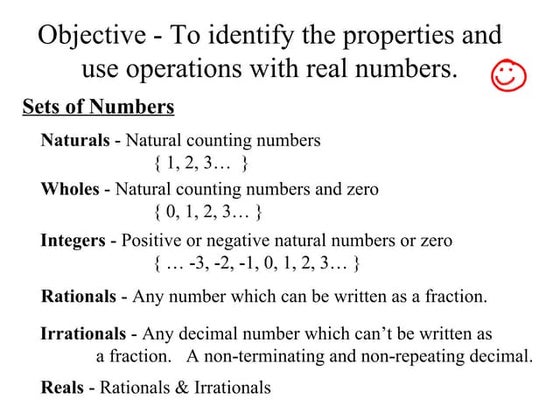



1.1 Real Numbers and Number OperationsSarah Stillwell
Ėý
Use a number line to graph and order real numbers.
Identify properties of and use operations with real numbers.Informe numeros reales



Informe numeros realeswiscarleisrodriguez
Ėý
This document defines and explains various sets of numbers including natural numbers, integers, rational numbers, irrational numbers, and real numbers. It provides properties and examples of operations like addition, subtraction, multiplication, and division on real numbers. Key points covered include:
- The definitions of natural numbers, integers, rational numbers, irrational numbers, and real numbers as sets.
- Properties of addition, subtraction, multiplication, and division for real numbers like commutativity, associativity, identity elements, and opposites.
- Absolute value and inequalities involving absolute value.M17 t1 notes 



M17 t1 notes chrystal_brinson
Ėý
The document provides step-by-step instructions for graphing rational functions. It explains that rational functions are fractions of polynomials, and defines key features like domains, zeros, vertical and horizontal asymptotes. Examples are given to demonstrate identifying these features and graphing the rational function based on them. Steps include finding intercepts, asymptotes, determining where the graph lies relative to the x-axis, and combining these elements to graph the full function.Polynomial PowerPoint Presentation for CBSE



Polynomial PowerPoint Presentation for CBSEprimepaathshala
Ėý
The students of class 8th-10th of CBSE/ICSE and other state boards can learn the concept of polynomial from this latest uploaded PowerPoint Presentation. This presentation has covered all the key concept and definition of Polynomial chapter of Math's. This presentation is also beneficial for teachers who want to teach Polynomial concept to their students. The slides have been designed to be used in smart screen for teaching. Number system



Number systemDEV YADAV
Ėý
- A number line consists of several types of numbers including natural numbers, whole numbers, integers, rational numbers, and irrational numbers.
- Rational numbers can be written as fractions p/q, while irrational numbers cannot. When writing decimals, rational numbers will either terminate or repeat, while irrational numbers will not terminate or repeat.
- There are methods to convert between rational numbers written as decimals and as fractions by multiplying or subtracting terms and solving for the value of the decimal. Geometric constructions can also represent irrational numbers.Recently uploaded (20)
Intellectual Honesty & Research Integrity.pptx



Intellectual Honesty & Research Integrity.pptxNidhiSharma495177
Ėý
Research Publication & Ethics contains a chapter on Intellectual Honesty and Research Integrity.
Different case studies of intellectual dishonesty and integrity were discussed.How to Configure Recurring Revenue in Odoo 17 CRM



How to Configure Recurring Revenue in Odoo 17 CRMCeline George
Ėý
This slide will represent how to configure Recurring revenue. Recurring revenue are the income generated at a particular interval. Typically, the interval can be monthly, yearly, or we can customize the intervals for a product or service based on its subscription or contract. Mastering Soft Tissue Therapy & Sports Taping



Mastering Soft Tissue Therapy & Sports TapingKusal Goonewardena
Ėý
Mastering Soft Tissue Therapy & Sports Taping: Pathway to Sports Medicine Excellence
This presentation was delivered in Colombo, Sri Lanka, at the Institute of Sports Medicine to an audience of sports physiotherapists, exercise scientists, athletic trainers, and healthcare professionals. Led by Kusal Goonewardena (PhD Candidate - Muscle Fatigue, APA Titled Sports & Exercise Physiotherapist) and Gayath Jayasinghe (Sports Scientist), the session provided comprehensive training on soft tissue assessment, treatment techniques, and essential sports taping methods.
Key topics covered:
â
Soft Tissue Therapy â The science behind muscle, fascia, and joint assessment for optimal treatment outcomes.
â
Sports Taping Techniques â Practical applications for injury prevention and rehabilitation, including ankle, knee, shoulder, thoracic, and cervical spine taping.
â
Sports Trainer Level 1 Course by Sports Medicine Australia â A gateway to professional development, career opportunities, and working in Australia.
This training mirrors the Elite Akademy Sports Medicine standards, ensuring evidence-based approaches to injury management and athlete care.
If you are a sports professional looking to enhance your clinical skills and open doors to global opportunities, this presentation is for you.Báŧ TEST KIáŧM TRA GIáŧŪA KÃ 2 - TIášūNG ANH 10,11,12 - CHUášĻN FORM 2025 - GLOBAL SU...



Báŧ TEST KIáŧM TRA GIáŧŪA KÃ 2 - TIášūNG ANH 10,11,12 - CHUášĻN FORM 2025 - GLOBAL SU...Nguyen Thanh Tu Collection
Ėý
https://app.box.com/s/ij1ty3vm7el9i4qfrr41o756xycbahmgAzure Administrator Interview Questions By ScholarHat



Azure Administrator Interview Questions By ScholarHatScholarhat
Ėý
Azure Administrator Interview Questions By ScholarHatOne Click RFQ Cancellation in Odoo 18 - Odoo šÝšÝßĢs



One Click RFQ Cancellation in Odoo 18 - Odoo šÝšÝßĢsCeline George
Ėý
In this slide, weâll discuss the one click RFQ Cancellation in odoo 18. One-Click RFQ Cancellation in Odoo 18 is a feature that allows users to quickly and easily cancel Request for Quotations (RFQs) with a single click.Full-Stack .NET Developer Interview Questions PDF By ScholarHat



Full-Stack .NET Developer Interview Questions PDF By ScholarHatScholarhat
Ėý
Full-Stack .NET Developer Interview Questions PDF By ScholarHatEffective Product Variant Management in Odoo 18



Effective Product Variant Management in Odoo 18Celine George
Ėý
In this slide weâll discuss on the effective product variant management in Odoo 18. Odoo concentrates on managing product variations and offers a distinct area for doing so. Product variants provide unique characteristics like size and color to single products, which can be managed at the product template level for all attributes and variants or at the variant level for individual variants.ASP.NET Interview Questions PDF By ScholarHat



ASP.NET Interview Questions PDF By ScholarHatScholarhat
Ėý
ASP.NET Interview Questions PDF By ScholarHatBISNIS BERKAH BERANGKAT KE MEKKAH ISTIKMAL SYARIAH



BISNIS BERKAH BERANGKAT KE MEKKAH ISTIKMAL SYARIAHcoacharyasetiyaki
Ėý
BISNIS BERKAH BERANGKAT KE MEKKAH ISTIKMAL SYARIAHHannah Borhan and Pietro Gagliardi OECD present 'From classroom to community ...



Hannah Borhan and Pietro Gagliardi OECD present 'From classroom to community ...EduSkills OECD
Ėý
Hannah Borhan, Research Assistant, OECD Education and Skills Directorate and Pietro Gagliardi, Policy Analyst, OECD Public Governance Directorate present at the OECD webinar 'From classroom to community engagement: Promoting active citizenship among young people" on 25 February 2025. You can find the recording of the webinar on the website https://oecdedutoday.com/webinars/
NUTRITIONAL ASSESSMENT AND EDUCATION - 5TH SEM.pdf



NUTRITIONAL ASSESSMENT AND EDUCATION - 5TH SEM.pdfDolisha Warbi
Ėý
NUTRITIONAL ASSESSMENT AND EDUCATION, Introduction, definition, types - macronutrient and micronutrient, food pyramid, meal planning, nutritional assessment of individual, family and community by using appropriate method, nutrition education, nutritional rehabilitation, nutritional deficiency disorder, law/policies regarding nutrition in India, food hygiene, food fortification, food handling and storage, food preservation, food preparation, food purchase, food consumption, food borne diseases, food poisoningHow to Configure Deliver Content by Email in Odoo 18 Sales



How to Configure Deliver Content by Email in Odoo 18 SalesCeline George
Ėý
In this slide, weâll discuss on how to configure proforma invoice in Odoo 18 Sales module. A proforma invoice is a preliminary invoice that serves as a commercial document issued by a seller to a buyer.Báŧ TEST KIáŧM TRA GIáŧŪA KÃ 2 - TIášūNG ANH 10,11,12 - CHUášĻN FORM 2025 - GLOBAL SU...



Báŧ TEST KIáŧM TRA GIáŧŪA KÃ 2 - TIášūNG ANH 10,11,12 - CHUášĻN FORM 2025 - GLOBAL SU...Nguyen Thanh Tu Collection
Ėý
Rational number class 8th
- 2. ï― DEFINITION OF RATIONAL NUMBERS ï― COMPARISON OF RATIONAL AND IRRATIONAL NUMBERS ï― PROPERTIES OF RATIONAL NUMBERS ï― OPERATIONS ON RATIONAL NUMBERS ï― ROLE OF â 0 â and â 1â ï― NEGATIVE OF RATIONAL NUMBERS ï― RECIPROCAL OF RATIONAL NUMBERS ï― REPRESENTATION OF RATIONAL NUMBERS ON NUMBER LINE ï― RATIONAL NUMBERS BETWEEN ANY TWO RATIONAL NUMBERS
- 5. ï― Def:- Rational numbers :- The numbers are of the form i)p/q form ii)p,q ÂĢ Z iii)qâ 0 ï― Rational numbers are indicated by capital â Qâ (QUOZIENTE---ITALIAN---QUOTIENT)
- 6. ï― CLOSURE PROPERTY:-If a , b are any two rational numbers then they are under 1. ADDITION a+bâŽQ--------- CLOSED 2. SUBTRACTION a-bâŽQ ---------CLOSED 3. MULTIPLICATION axbâŽQ---------CLOSED 4. DIVISION a÷bÉQ -------- CLOSED
- 7. If a , b are any two rational numbers then they are under 1. ADDITION a+b=b+a-------- TRUE 2. SUBTRACTION a-bâ b-a ------ FALSE 3. MULTIPLICATION axb=bxa-------TRUE 4. DIVISION a÷bâ b÷a ------------FALSE
- 8. ï― If a, b, c are any three rational numbers then they are under 1. ADDITION (a+b)+c=a+(b+c)----- TRUE 2. SUBTRACTION (a-b)-câ a-(b-c) --- FALSE 3. MULTIPLICATION (axb)xc=ax(bxc) --TRUE 4. DIVISION (a÷b)÷câ a÷(b÷c) --------FALSE
- 9. ï― When we multiply the given number by the other number the result is â1â.,then one of the number is the reciprocal of the other number. ï― then the multiplied number is calledâ multiplicative inverseâ ï― Here â 1â is called multiplicative identity of rational numbers.
- 10. ï― When a rational number is multiplied with the reciprocal or ï― multiplicative inverse of its own, result will be one (1) ï― i.e. ï― x/y à y/x = 1. Example: 2/7 à 7/2 = 1; etc.
- 11. ï― When any rational number is added to zero (0), ï― then it will result in the same rational number ï― i.e. ï― x/y + 0 = x/y. Zero is called the identity for the addition of rational numbers. Example: ï― 2/3 + 0 = 2/3; ï― -5/7 + 0 = -5/7; etc.
- 12. ï― When any rational number is multiplied with one (1), ï― then ï― it will result in the same rational number ï― i.e. x/y à 1 = x/y. One is called the multiplicative identity for rational numbers. Example: 2/7 à 1 = 2/7; ï― -8/3 à 1 = -8/3; etc.
- 13. ï― When we add any number to the given number the result is â0â. ï― Adding number is calledâ NEGATIVE OF A GIVEN RATIONAL NUMBERâ. ï― Then the added number is called a âadditive inverse â. ï― Here â0 â is called additive identity of rational numbers.
- 14. ï― ) When a rational number is added to the negative or ï― additive inverse of its own, ï― result will be zero (0) i.e. x/y + (-y/x) = 0. Example: 2/7 + (-7/2) = 0; etc.
- 15. : ï―Closure Property ï―Associative Property ï―Commutative Property ï―Distributive Property ï―Identity Property ï―Inverse property
- 16. Property Addition Multiplication Subtraction Division 1. Commutative Property x + y = y+ x x à y = y à x x â y â y â x x ÷ y â y ÷ x 2. Associative Property x + (y + z) = (x + y) +z x à (y à z) = (x à y) à z (x â y) â z â x â (y â z) (x ÷ y) ÷ z â x ÷ (y ÷ z) 3. Identity Property x + 0 = x =0 + x x à 1 = x = 1 à x x â 0 = x â 0 â x x ÷ 1 = x â 1 ÷ x 4. Closure Property x + y â Q x à y â Q x â y â Q x ÷ y â Q 5. Distributive Property x à (y + z) = x à y + xà z x à (y â z) = x à y â x à z
- 17. ï― Rational numbers can also be represented on the Number line
- 18. ï― Rational numbers can also be represented on the Number line example of 4/9 Step (1) In a rational number, the numeral below the bar, i.e., the denominator, tells the number of equal parts into which the first unit has been divided. The numeral above the bar i.e. the numerator, tells âhow manyâ of these parts are considered So in this particular example, we need to divide the first unit into 9 parts and we need to move to the 4th part
- 19. ï― Step (2) Draw the straight line. Divide the first unit into equal parts equal to the denominator of the rational number. And then mark each equal part to the right of the line and reach the desired number








